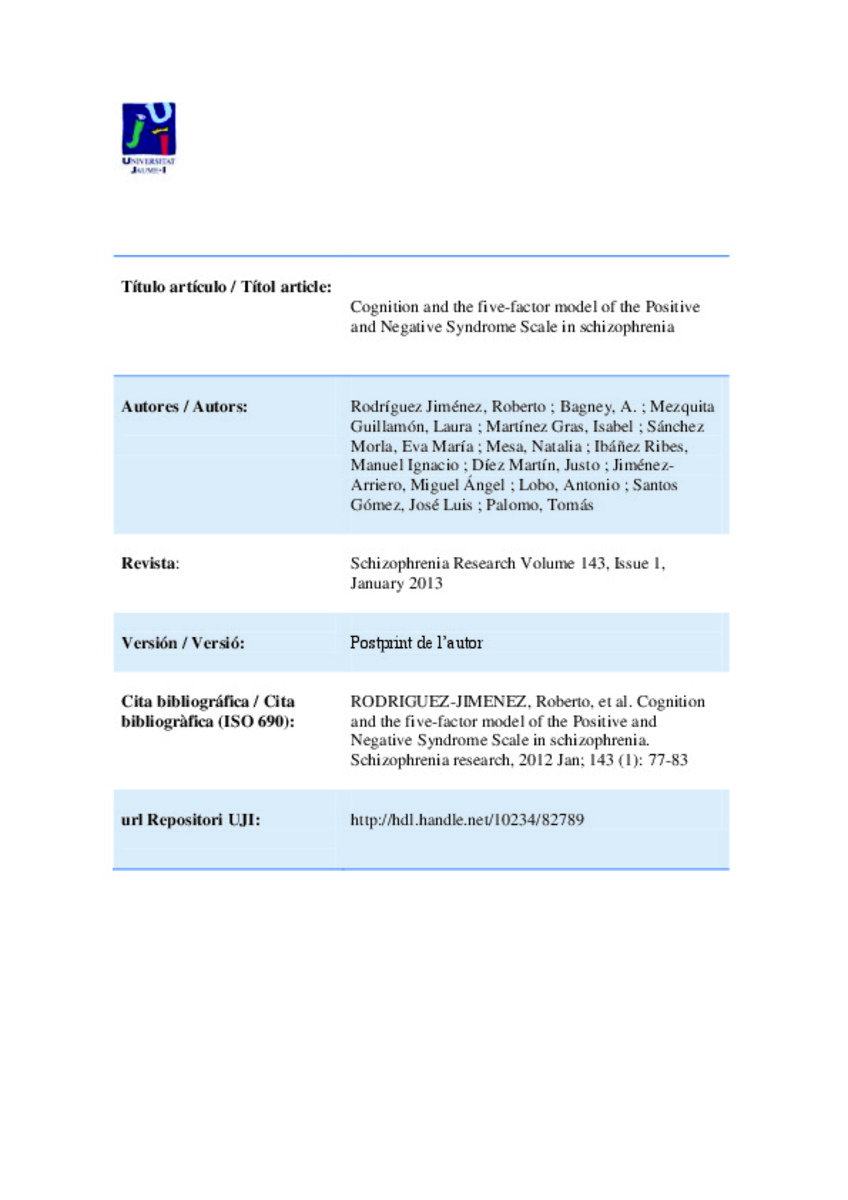Mostrar el registro sencillo del ítem
Cognition and the five-factor model of the Positive and Negative Syndrome Scale in schizophrenia
| dc.contributor.author | Rodríguez Jiménez, Roberto | |
| dc.contributor.author | Bagney, Alexandra | |
| dc.contributor.author | Mezquita, Laura | |
| dc.contributor.author | Martínez Gras, Isabel | |
| dc.contributor.author | Sánchez Morla, Eva María | |
| dc.contributor.author | Mesa, Natalia | |
| dc.contributor.author | Ibáñez, Manuel I | |
| dc.contributor.author | Díez Martín, Justo | |
| dc.contributor.author | Jiménez-Arriero, Miguel Ángel | |
| dc.contributor.author | Lobo, Antonio | |
| dc.contributor.author | Santos Gómez, José Luis | |
| dc.contributor.author | Palomo, Tomás | |
| dc.date.accessioned | 2014-02-10T08:43:28Z | |
| dc.date.available | 2014-02-10T08:43:28Z | |
| dc.date.issued | 2013-01 | |
| dc.identifier.citation | RODRIGUEZ-JIMENEZ, Roberto, et al. Cognition and the five-factor model of the Positive and Negative Syndrome Scale in schizophrenia. Schizophrenia research, 2012 Jan; 143 (1): 77-83 | |
| dc.identifier.uri | http://hdl.handle.net/10234/82789 | |
| dc.description.abstract | Different exploratory and confirmatory factorial analyses of the Positive and Negative Syndrome Scale (PANSS) have found a number of factors other than the original positive, negative, and general psychopathology. Based on a review of previous studies and using confirmatory factor analyses (CFA), Wallwork et al. (Schizophr Res 2012; 137: 246–250) have recently proposed a consensus five-factor structure of the PANSS. This solution includes a cognitive factor which could be a useful measure of cognition in schizophrenia. Our objectives were 1) to study the psychometric properties (factorial structure and reliability) of this consensus five-factor model of the PANSS, and 2) to study the relationship between executive performance assessed using the Wisconsin Card Sorting Test (WCST) and the proposed PANSS consensus cognitive factor (composed by items P2-N5-G11). This cross-sectional study included a final sample of 201 Spanish outpatients diagnosed with schizophrenia. For our first objective, CFA was performed and Cronbach's alphas of the five factors were calculated; for the second objective, sequential linear regression analyses were used. The results of the CFA showed acceptable fit indices (NNFI = 0.94, CFI = 0.95, RMSEA = 0.08). Cronbach's alphas of the five factors were adequate. Regression analyses showed that this five-factor model of the PANSS explained more of the WCST variance than the classical three-factor model. Moreover, higher cognitive factor scores were associated with worse WCST performance. These results supporting its factorial structure and reliability provide robustness to this consensus PANSS five-factor model, and indicate some usefulness of the cognitive factor in the clinical assessment of schizophrenic patients. | ca_CA |
| dc.format.extent | 6 p. | ca_CA |
| dc.format.mimetype | application/pdf | ca_CA |
| dc.language.iso | eng | ca_CA |
| dc.relation.isPartOf | Schizophrenia Research Volume 143, Issue 1, January 2013 | ca_CA |
| dc.rights | ELSEVIER © 2013 | |
| dc.rights.uri | http://rightsstatements.org/vocab/InC/1.0/ | * |
| dc.subject | Schizophrenia | ca_CA |
| dc.subject | PANSS | ca_CA |
| dc.subject | CFA | ca_CA |
| dc.subject | Cognitive factor | ca_CA |
| dc.subject | WCST | ca_CA |
| dc.subject | Cognition | ca_CA |
| dc.subject.other | Esquizofrènia | ca_CA |
| dc.title | Cognition and the five-factor model of the Positive and Negative Syndrome Scale in schizophrenia | ca_CA |
| dc.type | info:eu-repo/semantics/article | ca_CA |
| dc.identifier.doi | http://dx.doi.org/10.1016/j.schres.2012.10.020 | |
| dc.rights.accessRights | info:eu-repo/semantics/openAccess | ca_CA |
| dc.relation.publisherVersion | http://www.sciencedirect.com/science/article/pii/S0920996412005920 | ca_CA |
| dc.type.version | info:eu-repo/semantics/acceptedVersion | ca_CA |
Ficheros en el ítem
Este ítem aparece en la(s) siguiente(s) colección(ones)
-
PSB_Articles [1301]
Articles de publicacions periòdiques







